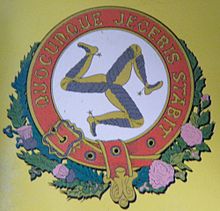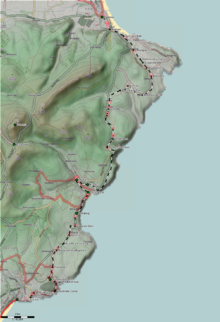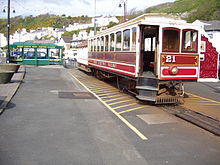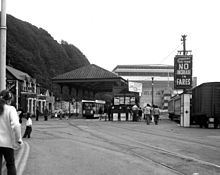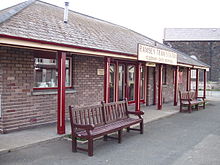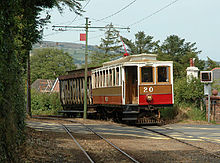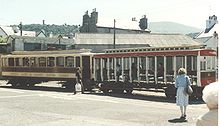- Manx Electric Railway
-
Coordinates: 54°09′25″N 4°27′50″W / 54.157°N 4.464°W
Manx Electric Railway 
Douglas Derby Castle (for Douglas Horse Trams) 


Derby Castle Depôt 
Groudle Glen 
Groudle Viaduct 
A2 Balladromma Beg 
Baldrine 
Ballabeg 
Fairy Cottage 
Preston's Crossing 
South Cape 


Laxey Car Sheds 
Laxey Sub-Station 
Glen Roy Viaduct 


Laxey 




A2 New Road Laxey 




Snaefell Mountain Railway 
Minorca 
Minorca Vale 
Dhoon Glen 
Ballajora 
Port Lewaigue 
Belle Vue 
Ballure Viaduct 
A2 Ballure Glen 


Ramsey Car Sheds 
Ramsey (Plaza) The Manx Electric Railway is an electric inter-urban tramway connecting Douglas, Laxey and Ramsey in the Isle of Man. It connects with the Douglas Bay Horse Tramway at its southern terminus at Derby Castle at the northern end of the promenade in Douglas, and with the Snaefell Mountain Railway at Laxey. The railway's route is undulating and passes through areas of scenic beauty. For that reason, among others, many holiday visitors to the Isle of Man take an excursion on one of the trams.
Contents
Beginnings
The line is built to 3 ft (914 mm) gauge and is 17 miles (27.4 km) long from terminus to terminus. It is largely segregated from road traffic, running over two tracks on roadside reservation or private right-of-way, and is electrified using overhead line at 550 volts direct current. Initially the means of power was supplied to the tramcars by bow collectors (still employed on the Snaefell Mountain Railway today, owing to its constant connection with the overhead lines and dependability in strong winds on the mountain) but by the turn of the 20th century cars were fitted with trolley poles, the method still employed today. Originally the electricity was generated by the railway's own power stations though they are now supplied via the island's grid by the Manx Electricity Authority. Having operated a year-round service from its inception, the line now still provides service throughout the year although the winter service is much less frequent than the summer service and has been intermittently dropped from schedules in recent years altogether to allow a substantial investment in infrastructure and permanent way in addition to relaying longer stretches of rails and sleepers without disturbance.
Operations
Originally the service was provided by about 24 electric tramcars and the same number of trailers: the earliest date from 1893 and almost all are pre-1910. Two of the original three cars that opened the line in 1893 are still in use, and are the oldest electric tramcars still at work on their original line anywhere in the world. The design of Manx tramcars pre-dates any consensus on tramcar design, and so they have quite distinctive boxy bodies. Most services are operated by a motor car towing a single trailer, although later cars can easily haul two trailers. This has never been common practice (in recent years this has been included in a few "special" services as part of the long-running series of events on the railway) although it was not uncommon for service cars to also haul a closed box-van for freight goods and, until 1975, a mail van. In September 1975 the line was closed between Laxey-Ramsey and the contract with the Post Office was lost but since this time a limited winter service has operated on weekdays though this was suspended in 1998 as an economy measure. Today, the railway operates a seasonal timetable with services terminating at either Laxey or Ramsey, with some shorter workings in connection with the Groudle Glen Railway in peak season and limited evening operations as far as Laxey in peak season to tie in with evening services on the Snaefell Mountain Railway which, since 2009, has provided a weekly Sunset Dinner service including rail travel and a meal at the summit. The possibility of a limited evening service returning to Ramsey in the future has also been considered in recent times and trams are sometimes hired on a charter basis during the summer months for special enthusiasts' excursions.
Ownership
The first section of the line, from the northern end of the promenade at Douglas to Groudle Glen, opened in 1893, the line reaching Laxey in 1894 (the mountain railway was established the following year and starts from Laxey Station within the same environs) and finally Ramsey in 1899. The first section of the line was built by a company titled Douglas Bay Estates Ltd., and by 1894 the tramway had been acquired by the Douglas & Laxey Electric Tramway Co. Ltd. which changed its name to the Isle of Man Tramways & Electric Power Co. Ltd. (I.o.M.T.&.E.P.) in the same year. The I.o.M.T.&.E.P. went into liquidation in 1900 as a consequence of a banking collapse. The tramway was sold by the liquidator to the newly formed Manx Electric Railway Co. Ltd., which took over the services in 1902. By the late 1950s the Manx Electric Railway Co. Ltd. was itself in financial difficulties, and in 1957 the company and its assets were acquired by the Isle of Man Government (they carried out a similar move two decades later to save the Isle of Man Railway) at which point a nationalisation livery of green and white was applied to some trams and trailers for a limited time though this was unpopular and later dropped. A government Board was formed to manage the line and the Snaefell Mountain Railway, and still does so after various changes of title from the original Manx Electric Railway Board later becoming the Isle Of Man Passenger Transport Board, and it is now operated under the banner heading of Isle Of Man Heritage Railways (the word heritage being added in 2009). This is a division of the Department of Community, Culture & Leisure of the Isle of Man Government, and is also responsible for the operation of the island's buses under the banner of Bus Vannin.
Stations
Main article: Manx Electric Railway StationsThere are several established intermediate stations, but Groudle Glen, Laxey, Dhoon Glen, Cornaa and Ballaglass Glen are the main stations shown in the timetables. The official stopping points usually have a basic waiting shelter (more recent additions have been modern bus shelters), and there are also a number of "unofficial" stopping points along the line and these sometimes carry "request stop" notices but are not given station nameboards or any other passenger facilities. Several have been dubbed with titles in the more rural areas that cite the name of the nearby farm or farmer; these are most prevalent in the northern section with names such as Rome's Crossing, Watson's Crossing and Dhoon Farm, but none of these occasional stopping places have ever carried their own names. Some lesser-known stopping points are also known by their nearest pole number, with the overhead lines being carried by a succession of these, numbered between 1 and 1,904 from Derby Castle to Ramsey Plaza. Owing to the inter-urban nature of operations tram cars will stop within reason at any point where it is safe to do so, the notable exceptions being where the line runs parallel to a main road; the majority of the first section of the line as far as Baldrine Station runs in this way, as do sections on the approach to the northern terminus as the line runs into the suburban area of Ramsey. These sections were originally toll roads, installed at the same time as the tramway.
Tramcars & Trailers
Main article: Manx Electric Railway Rolling StockThe line is in many ways unique, not least because it still operates entirely with its original rolling stock with the exception of winter saloon 22 which was completely rebuilt following a fire in 1992 after which the coachwork was no longer usable. A considerable amount of stock was lost in a disastrous fire at Laxey in 1930 but other than this all the original stock remains. In recent times the storage of excess stock has become something of a political "hot potato" with several historic vehicles stored off-site, with all of these items returning to home territory in November 2009 though these particular items remain in store and out of use requiring some considerable attention before returning to traffic in many cases. The line and its stock are in the custody of the Isle of Man Government as part of the Department of Community, Culture & Leisure and as such do not see the requirement to retain unused stock, which has no potential use or long-term storage place on the railway. In addition, the line has a tram from the Lisbon tramway network purchased in 1999, but this has never seen use on the line due to clearance difficulties (it was used as a passenger waiting shelter for a spell). This particular vehicle is no longer housed on the railway, but remains on the island.
Service Fleet
The following trams were in use on passenger services during the 2010 season, with the mainstay of the services being provided by either winter saloons or tunnel cars. Original tramcars 1 and 2 are both operational but do not usually operate in day=to-day use, tunnel cars 5 and 6 see use in peak summer season and illuminated car 9 (also a member of this class) is used in conjunction with the evening services on the Groudle Glen Railway in July and August; the backbone of the fleet are the so-called winter saloons, numbered 19-22 which operate the core timetable. Also there are a number of servicable open toastracks, these being numbers 26, 32 and 33 (the latter two being the most powerful on the line). Many other cars remain in the railway's possession albeit out of service and in some cases stored off-site, apart from those items that were lost in the 1930 fire at Laxey. In addition to these motor cars the following trailers have seen use some use including lightweight trailers 37 and 49, bulkheads 40-48 which usually accompany the winter saloons, lightweight trailer 51, converted disabled saloon 56, closed saloons 57 and 58 and 61-62. The line's Royal Saloon, No. 59, makes rare public appearances also. As part of the island's annual transport festival Car 32 occasionally operates a special evening service hauling two trailers, an unusual occurrence despite the later cars being built with the capability to operate in this way. Of note in the remaining fleet car 7 was relegated to permanent way duties for a number of years but has been restored for return to traffic in 2011, locomotive 23 is privately owned, car 34 (previously No. 7 Maria on the Snaefell Mountain Railway and regauged) is undergoing maintenance, and other cars are receiving remedial attention as and when time and funding allows.
Temporary Closures
The section of the railway between Laxey Station and the northern terminus at Ramsey Plaza has been controversially closed twice in the line's history, the first instance being in 1977, but owing to public outcry it was reopened with due ceremony later in the year. During part of the summer of 2008 after a consultancy report commissioned by the Isle of Man Government exposed critical failings in the permanent way, deeming it unsuitable for carrying a public passenger service in the near future.[1] But the island's parliament, Tynwald, agreed to spend nearly £5m for track replacement during July–September, allowing trains to run on one track,[2] according to a news report. Manx authorities were considering the use of vintage buses as a replacement during the closure, reports previously stated. The resignation of the Tourism and Leisure Minister Adrian Earnshaw was called for by enthusiasts and Chief Minister Tony Brown ordered an urgent review of the closure decision. He also ordered an independent inquiry into how the track had been allowed to get into such a state that it posed a risk to safety.[3] In 2009 the full line operated continuously and has continued to do so since the beginning of the season following at Easter with no rail-related incidents affecting the operation of the services. In the past the tramway has operated a winter service and this continued until 1998 in one form or another but since this time the line has only been operated seasonally, usually between March and the beginning of November though this can vary from season to season.
Incidents
Owing to the nature of the railway's open and ungated level crossings there have been a number of minor collisions,[4] Since the increase in road traffic during the line's existence these have become more commonplace but are usually minor incidents; the seasonal nature of the line's operations has ensured that warning signage to alert motorists that trams are operating has been erected at the start of each season in recent times to eliminate this risk, however, on occasion incidents do still occur. There are a great number of occupational crossings throughout the line's route, some of which have restricted visibility to motorists. The most recent of these took place on Monday, 27 July 2009, when a vehicle carrying a mechanical excavator came into contact with the overhead wires supplying traction power to both the low road and the Snaefell Mountain Railway at a busy road crossing in Laxey; there were no injuries. Police and the railway's electrical engineering crews attended the scene of the incident, the report also said. It did not indicate what damage had occurred as a result of the incident. Service resumed the next day after temporary repairs to the overhead lines, which was to be permanently repaired over the subsequent couple of weeks. An investigation into the incident was scheduled to take place later.[5]
See also
- British narrow gauge railways
- Heritage railways in the Isle of Man
- List of light-rail/tram systems
- Maley & Taunton
- Transport on the Isle of Man
References
- ^ "Manx Electric Railway and Steam Railway Condition Reports". http://www.gov.im/cso/cdl_report.xml.
- ^ Jones, Robin (10 April - 7 May 2008). "Closed Manx Electric section to reopen in July". Heritage Railway magazine (Horncastle, Lincolnshire: Mortons Media Group Ltd.) (110): p32.
- ^ Jones, Robin (13 March - 9 April 2008). ""Resign" calls after minister shuts Manx Electric line". Heritage Railway magazine (Horncastle, Lincolnshire: Mortons Media Group Ltd.) (109): p24.
- ^ and these are reported in the local press.
- ^ Manx Independent page3 dated 31 July 2009 Isle of Man Newspapers ISSN1358-4391
External links
- Isle of Man Transport
- Manx Electric Railway Society
- Manx Electric Railway
- Tram Travels/Sporvognsrejser: MERS - Manx Electric Railway Society
Sources
- Goodwyn, A.M. (1976) Is This Any Way To Run A Railway ? - The story of the Manx Electric Railway since 1956., Manx Electric Railway Society website, accessed 24 November 2006
- Goodwyn, M., (1993) Manx Electric, Platform 5 Publishing, ISBN 1-872524-52-4
- Hendry, R., (1993), Rails in the Isle of Man: A colour celebration, Midland Publishing Limited, ISBN 1-85780-009-5
 Heritage railways in the Isle of Man
Heritage railways in the Isle of ManHeritage Railways: England · Scotland · Wales · Northern Ireland · Isle of Man · Channel Islands Trams in Europe Sovereign
states- Albania
- Andorra
- Armenia
- Austria
- Azerbaijan
- Belarus
- Belgium
- Bosnia and Herzegovina
- Bulgaria
- Croatia
- Cyprus
- Czech Republic
- Denmark
- Estonia
- Finland
- France
- Georgia
- Germany
- Greece
- Hungary
- Iceland
- Ireland
- Italy
- Kazakhstan
- Latvia
- Liechtenstein
- Lithuania
- Luxembourg
- Macedonia
- Malta
- Moldova
- Monaco
- Montenegro
- Netherlands
- Norway
- Poland
- Portugal
- Romania
- Russia
- San Marino
- Serbia
- Slovakia
- Slovenia
- Spain
- Sweden
- Switzerland
- Turkey
- Ukraine
- United Kingdom
- (England
- Northern Ireland
- Scotland
- Wales)
States with limited
recognition- Abkhazia
- Kosovo
- Nagorno-Karabakh
- Northern Cyprus
- South Ossetia
- Transnistria
Dependencies
and other territories- Åland
- Faroe Islands
- Gibraltar
- Guernsey
- Jan Mayen
- Jersey
- Isle of Man
- Svalbard
Other entities Categories:- Heritage railways in the Isle of Man
- 3ft gauge railways
- Narrow gauge railways in the Isle of Man
Wikimedia Foundation. 2010.

